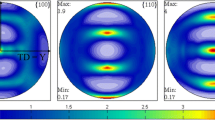Abstract
Injection molding is one of the most important processes for manufacturing plastic parts, but residual stresses are generated due to non-uniform temperature distribution in the mold cavity. It is important to predict the internal stress development during molding and after ejection and measurement of the residual stress distribution is needed to verify the prediction of the residual stresses. The incremental hole-drilling method was employed to evaluate residual stresses in injection-molded parts. An experimental investigation is performed to study the effect of induced drilling stresses in incremental hole-drilling method. While the ultra sonic mill for the through-hole drilling would tend to satisfy the low-induced-stress requirement, UV laser processing could not somewhat satisfy the quality of the bottom surface of the hole. This study reports hole-producing techniques that might be suitable for the general requirements of residual stress measurement by the hole-drilling method.
Similar content being viewed by others
References
G. Pötsch and W. Michaeli, “Injection Molding: an Introduction”, Hanser Publishers, New York, 1995.
P. Postawa and D. Kwiatkowski, J. Achiev. Mater. Manufact. Eng., 18, 171 (2006).
S. K. Kim, S. W. Lee, and J. R. Youn, Korea-Aust. Rheol. J., 14, 107 (2002).
A. Guevara-Morales and U. Figueroa-Lopez, J. Mater. Sci., 49, 4399 (2014).
Measurement Group, “Measurement of Residual Stresses by the Hole-Drilling Strain Gage Method”, Tech Note TN-503-5, pp. 1–20, Raleigh, NC, 1993.
J. Mathar, Trans. ASME, Iron & Steel, 56, 249 (1934).
ASTM International, “Annual Book of ASTM E837-13a”, 2013.
C. H. Kim and J. R. Youn, Polym. Test., 26, 862 (2007).
M. T. Flaman and B. H. Manning, Exp. Mech., 25, 205 (1985).
H. P. Wnuk, Exp. Mech., 19, 23 (1979).
M. Honner, P. Litos, and M. Svantner, Infra. Phys. Tech., 45, 131 (2004).
J. P. Nobre, J.-H. Stiffel, A. Nau, and J. C. Outeiro, CIRP Annals, 60, 87 (2013).
J. P. Nobre and J. C. Outeiro, Procedia CIRP, 31, 215 (2015).
G. Mathieu, V. Frederic, R. Joel, and F. Eric, Procedia CIRP CSI, 45, 79 (2016).
K. M. B. Jansen, J. J. W. Orij, C. Z. Meijer, and D. J. Van Dijk, Polym. Eng. Sci., 39, 2030 (1999).
M. Hasan, J. Zhao, and Z. Jiang, J. Manuf. Process., 29, 343 (2017).
Author information
Authors and Affiliations
Corresponding author
Rights and permissions
About this article
Cite this article
Kim, C.H. Investigation on the Hole-producing Techniques of Residual-stress Measurement by Incremental Hole-drilling Method in Injection Molded Part. Fibers Polym 19, 1776–1780 (2018). https://doi.org/10.1007/s12221-018-8332-7
Received:
Revised:
Accepted:
Published:
Issue Date:
DOI: https://doi.org/10.1007/s12221-018-8332-7




